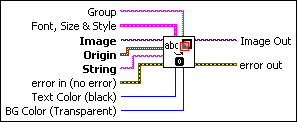IMAQ Overlay Text VI
Owning Palette: OverlayInstalled With: NI Vision Development ModuleOverlays text on an image.









 |
Group specifies the group to which you want to add the overlay information. If no name is specified, the overlay information is added to the default group. |
||||||||||||||||||||||||||||||||||||||||||||||||
 |
Font, Size & Style is a cluster that enables the user to choose the font, size, style, and alignment of the text. This cluster contains the following elements:
|
||||||||||||||||||||||||||||||||||||||||||||||||
 |
Image is a reference to the source image. |
||||||||||||||||||||||||||||||||||||||||||||||||
 |
Origin is the location on the image to overlay the text. This parameter is dependent on the values of Horizontal Alignment and Vertical Alignment.
|
||||||||||||||||||||||||||||||||||||||||||||||||
 |
String is the text to overlay. |
||||||||||||||||||||||||||||||||||||||||||||||||
 |
error in (no error) describes the error status before this VI or function runs. The default is no error. If an error occurred before this VI or function runs, the VI or function passes the error in value to error out. This VI or function runs normally only if no error occurred before this VI or function runs. If an error occurs while this VI or function runs, it runs normally and sets its own error status in error out. Use the Simple Error Handler or General Error Handler VIs to display the description of the error code. Use error in and error out to check errors and to specify execution order by wiring error out from one node to error in of the next node.
|
||||||||||||||||||||||||||||||||||||||||||||||||
 |
Text Color (black) is the color of the text. |
||||||||||||||||||||||||||||||||||||||||||||||||
 |
BG Color (Transparent) is the background color of the text overlay. |
||||||||||||||||||||||||||||||||||||||||||||||||
 |
Image Out is a reference to the destination image. If Image Dst is connected, Image Dst Out is the same as Image Dst. Otherwise, Image Dst Out refers to the image referenced by Image Src. |
||||||||||||||||||||||||||||||||||||||||||||||||
 |
error out contains error information. If error in indicates that an error occurred before this VI or function ran, error out contains the same error information. Otherwise, it describes the error status that this VI or function produces. Right-click the error out indicator on the front panel and select Explain Error from the shortcut menu for more information about the error.
|
Details
Overlays are nondestructive, which means that they do not overwrite the underlying pixel values. You can save overlay information with an image by using the IMAQ Read Image And Vision Info VI. If you want to replace the underlying pixel values with the overlay values, use the IMAQ Merge Overlay VI.
Examples
Refer to the following for an example that uses this VI.
- LabVIEW\examples\Vision\3. Applications\Fuse Inspection Example.llb








